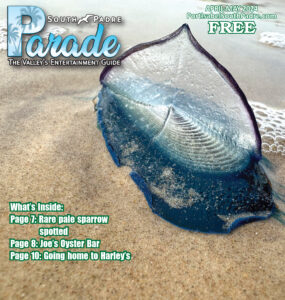By JIM FOSTER
Special to the Parade
It was only a short time ago when I was amongst a spread of full-bodied decoys, watching a flight of the large variety Canadian geese set their wings and begin floating into my spread.
As I lay in my ground blind watching, the large birds flared, acquired altitude extremely fast, and soon were well out of shotgun range. Looking over my shoulder, I saw the reason the birds had left the area – one of those game warden-type people walking in my direction.
After expressing my opinion of his timing and lack of manners, I showed my license. “How about a duck stamp?” was his next question. I produced the “stamp” and was told to have a good day and with somewhat of a sarcastic grin he left.
Never mind the lack of people skills exhibited by the game warden; I am always ready to show my Federal Waterfowl and Conservation Stamp.
The Federal Migratory Bird Hunting and Conservation Stamp, commonly known as “Duck Stamp,” are pictorial stamps produced by the U.S. Postal Service for the U.S. Fish & Wildlife Service and are not valid for postage.
Originally created in 1934 as the federal licenses required for hunting migratory waterfowl, Federal Duck Stamps have a much larger purpose today.
Federal Duck Stamps are a vital tool for wetland conservation. Ninety-eight cents out of every dollar generated by the sales of Federal Duck Stamps goes directly to purchase or lease wetland habitat for protection in the National Wildlife Refuge System.
Some of the local wildlife refuge personal should remember this when shutting hunters out of their private playgrounds. The Federal Duck Stamp Program has been called one of the most successful conservation programs ever initiated. Waterfowl are not the only wildlife to benefit from the sale of Federal Duck Stamps.
Numerous other birds, mammal, fish, reptile, and amphibian species that rely on wetland habitats have prospered. An estimated one-third of the nation’s endangered and threatened species find food or shelter in refuges established using Federal Duck Stamp funds.
So the question is asked, I don’t hunt waterfowl, why should I buy a stamp?
Birders and other frequenters of National Wildlife Refuges purchase a $15 Federal Duck Stamp each year in order to gain free admission to refuges. Conservationists buy Federal Duck Stamps because they know that the stamps are, dollar for dollar, one of the best investments one can make in the future of America’s wetlands.
Many states have now added duck stamps to their license requirements – a few of these states even use the money for conservation, but many just place the money in their general fund.
As the field quieted down, another flight of geese took note of my decoys and set their wings sailing in my direction. At my side, the German Wirehair Pointer fidgeted a little while watching the incoming birds. Just another minute, wait for it, and then …
To learn more about the “Duck Stamp,” contact the U.S. Fish and Wildlife Service – The Federal Duck Stamp Program – 4401 North Fairfax Drive – Mail Stop: MBSP-4070 – Arlington, VA 22203-1622 – Phone: (703) 358 -1714 – Fax: (703) 358-2009 – Email: duckstamps@fws.gov.
Editor’s Note: To see more of Jim’s writing and photography, visit www.fosteroutdoors.blogspot.com. If you have comments or news for Jim Foster, email him at jimf06@gmail.com.



Comments